Go Back to Syllabus
Go Back to Earth Camp Course Notes Directory
A short history of life
We can look at things 3 ways:
1. History of the key changes in life that have had major biogeochemical consequences.
2. A history of the diversity of life, including mass extinctions.
3. The appearance of major groups.
1. History of the key changes in life that have had major biogeochemical consequences.
A. Origin of life clouded in mystery.
Suspect early atmosphere was reducing, that is full of substances that are electron donors.
Atmosphere was probably mostly N and CO2 with CH4 (methane) and possibly NH4 (ammonia), HCN (hydrogen cyanide), and of course water vapor.
Famous Miller-Urey experiment showed that complex organics could form in such an atmosphere in the presence of a source of energy (spark).
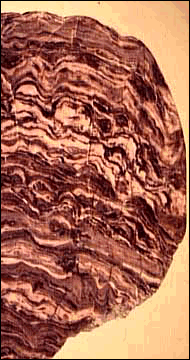
More recently it has become clear that many complex organics are present in space, on asteroids and especially comets.
Thus, we are pretty sure the early oceans were a organic "soup" the so called "primordial soup".
What is still pretty much a mystery is the origin of heredity and reproduction. Its possible that the surface of clay or some other mineral acted as a template for organization, but its very hypothetical and key experiments have yet to be performed or even rationalized.
B. However it happened, we are fairly sure it happened early in Earth's history because fossil carbon in 3.7 billion year old rocks and stromatolites from about the same time have the telltale signs of life.
Kona Dolomite (Michigan) 2.2 billion years old stromatolite fossil (from World Wide Museum)
We are positive that the earliest life forms were prokaryotes, such as bacteria and cyanobacteria.
Evidently, photosynthesis must have started nearly at the beginning. At once that changed the world because of the release of free oxygen.
C. Up to 2 billion years ago the O2 produced by photosynthesis was used up by the oxidation of reduced iron Fe2+ to Fe3+. Oxygen, an oxidizing agent, is an electron acceptor. Iron is soluble in compounds in the Fe2+ state but insoluble in Fe3+ compounds such as Fe2O3.
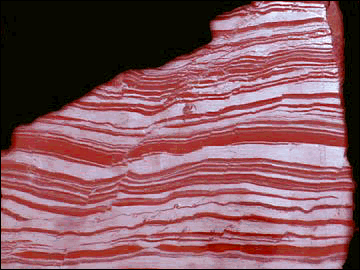
Banded Iron Formation (Michigan) (from World Wide Museum)
Cycles in photosynthesis thus produced cycles in O2 in the water column, which produced cycles in the oxidation and then deposition of Fe3+ compounds on the ocean floor. Likewise the draw down of CO2 in the water column would produce an increase in the pH of the water and an increase in the solubility of Si. But when photosynthesis was operating at lower levels, the pH went down and the deposition of Si would take place.
Thus we get what are called banded iron formations, which consist of bands of Fe2O3 alternating with Si and Fe2S.
This continues until 2 billion years ago, when we see the first appearance of red beds.
These indicate that O2 is building up in the atmosphere.
About the same time, BIFs decline, an indication that reducing compounds are disappearing from the oceans.
D. At about 1.9 billion years ago we see the first fossils of eukaryotes. These are colonies of obligate prokaryotes with a clear division of labor.
1) they are much larger than prokaryotes.
2) they often lack a mucoprotein outer cell wall
3) they have a complex architecture of internal membranes
4) they have a nucleus surrounded by a membrane
5) later forms have mitochondria, and if photosynthetic they have chloroplasts. Many organelles seem to have their origin as free-living prokaryotes.
6) they are much more internally homeostatic than prokaryotes and much more buffered against genetic change with the draw back that they are much more limited metabolically and slower to evolve.
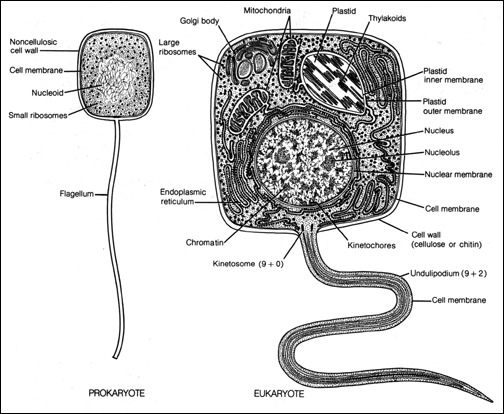
(from Margulis and Schwartz, 1982)
Eukaryotic metabolism can get going at about 2 % present O2 levels, which is consistent with the appearance of common red beds at about the same time. Some photosynthetic eukaryotic organisms develop colonial forms and the first "sea weeds occur". This is first good evidence of eukaryotic multicellularity.
The development of sex allows for species in the same sense we know them know lineages of interbreeding individuals.
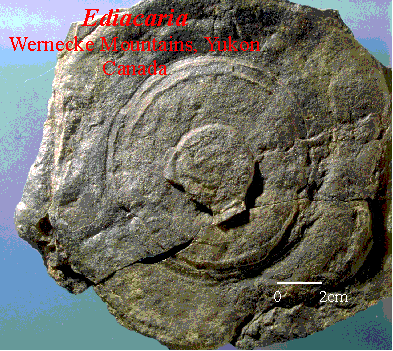
(from Miller Museum Online Exhibit)
E. In the Proterozoic, the Earth's climate seems to have gone through great swings. There may have been glaciers in the tropics at times, alternating with times of more normal carbonate deposition as we seen today in the warn regions. This suggests oscillating CO2 levels. I suspect that CO2 levels were basically at the whim of tectonic events during this period. undamped forcing with few damping negative feed backs resulting in dramatic oscillations. This is a major focus of research.
F. By about 0.7 billion years ago we see multicellular creatures or considerable complexity. The most common forms occur in what is called the Ediacaran assemblage, first identified in Australia, but present world-wide.
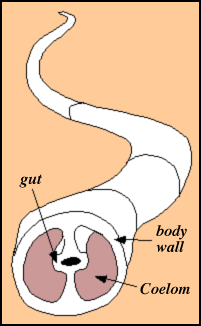
Ediacarans are rather large forms that all seem to be sac or quilted in stucture. Although superfically similar to several animal phyla, it is unclear if any belong to extant groups. Adolph Sielacher places them all in their own phylum, he calls the Vendizoa.
The basic structure of a coelom.
These creatures are found in very shallow water environments and it looks like they depended on a large surface area, perhaps to get as much O2 as possible.
G. The appearance of large size suggest developmental processes and origin the homeobox system - key to metazoan life. Allows for ordered developmental sequence and body part homology. This allows far greater levels of complexity and the development of hierarchical levels of organization of sub units into larger units.
H. At the same time we see bioturbation which implies the origin of a coelom. A sac separating an outer body wall from organs inside an animal.
This allow larger organisms that can have a hydrostatic skeleton and the ability to bend an twist and push even thought hey are large. Major modification of the sediments result. And oxidative processes can now go on at depth. Hence the efficiency of use of carbon fixed by photosynthesis increases.
I. At 540 million years ago there is a massive increase in the kinds of multicellular animal present. Could be do to the first wave of multicellular plants on land - perhaps mosses and lichens - very poor evidence. But that would increase the burial rate of organic carbon which would allow for many more animals in the oceans.
This is the Cambrian explosion. Famous example if the Burgess shale. It looks like all major animal phyla, perhaps all of them, were around by the middle Cambrian. By the end of the Cambrian the Phanerozoic pattern of marine organisms was pretty much established.
J. the next major event was the development of vascular land plants. Beginning in the Ordovician and culminating in the Late Devonian. Land plants became bigger and bigger and more and more divorced from relying on water for reproduction.
Ferns and their allies reproduce with alternation of generation. The fern you see is the so called sporophyte generation. It produces spores which float though the air, land and sprout into green liver-like gametophytes, which shed egg and sperm into water which unite with eggs to produce the next sporophyte generation.
They need water to reproduce, which is why they are most abundant in wet areas.
By the late Devonian the seed was invented. Here the sporophyte plant produces a male gametophyte which becomes a pollen grain, which floats in the air to the female gametophyte, still attached to a sporophyte. The male gametophyte puts down a pollen tube, fertilizing the egg in the female gametophyte. An embryo develops with a storage of food in a hard capsule, we call a seed.
No water needed for this reproduction. Trade off is that dispersal is slower since the seed is so very much bigger.
Now the locus of the Earth's biomass shifts from the sea to the land.
By the late Devonian there is a fairly diverse soil community, very similar to what wee will see when we look at modern soils later on. Mites, spring tails, millipedes and lots of carnivores to feed on them.
K. But vascular plant material is tough stuff. Once buried the lignin in woody material hardly breaks down at all. Early on in the Devonian and in the next period, the Carboniferous, there is hardly anybody around big to eat the woody matter.
Some sucking insects, a very few leaf biters, even rarer wood burrowers.
In the late Devonian amphibians evolve and by the middle carboniferous we have the origin of the Amniotic egg, which frees terrestrial vertebrates from the water in the same way the seed does for plants.
But even towards the end of the Carboniferous, there are no full time vertebrate herbivores - just a few with teeth that could handle some leafy or fruity tissue. In fact the terrestrial vertebrate community was dominated by carnivores - with the base of the food chain being aquatic, not land plant based. If you look at just the land animals the food pyramid looks upside down.
It is during this time that the rate of burial of terrestrial plant matter dramatically increases as seen in the delta 13C curve. Some say this is do to the development of vast swamps. In swamps, the decay of vascular plant matter ins impeded by burial in water saturated conditions, preventing aerobic decay.
But I believe this is do the lack of abundant herbivory which now mills down vascular plant matter to high-surface are bits that can be readily attacked by bacteria, fungi, and small soil animals.
Hence the ecosystem efficiency of the terrestrial world was low and carbon accumulated in a much wider range of environments than now.
As a consequence of the burial of this organic matter, O2 levels probably reached our current levels in the Carboniferous, but were kept from going higher by fire and the burial of nutrients.
The plants also fertilized the chemical weathering process which almost certainly massively increase the burial rate of inorganic carbon as carbonate. The enlargement of the pool of carbonate in the oceans kept the equilibrium levels of CO2 in the atmosphere much lower.
L. During the peak of land plant spread, in the Late Carboniferous, the World plunged into a long glacial age, almost certainly due to plant-mediated weathering.
M. Perhaps we came out of this glacial world in the Permian because of the evolution of many new herbivores. Vertebrate herbivores finally become more abundant than carnivores and for the first time the familiar ecological pyramid is recognizable.
A major driving force for this other than the terrestrial vertebrates were certainly the insects and termites may well have evolved in the Permian.
Ecosystem efficiency rose, the burial of plant matter slowed, and chemical weathering slowed.
N. We moved from the ice house to the greenhouse.
By the end of the Triassic Period we see herbivores that can eat trees. To handle such leafy and wood matter it helps a lot to get very big so that the food stays a long time in the gut and gut floras that digest cellulose can exist.
In the Jurassic, vertebrate herbivores became gigantic.
O. In the Cretaceous Angiosperm herbaceous plants evolved capable of much faster growth and reproduction than gymnosperms. Now there was much more abundant low browse and herbivorous dinosaurs tended to get smaller.
However the total amount of ground covered by plants was increasing and hence weathering was beginning to be enhanced once more.
P. Dinosaurs were wiped out at the Cretaceous-Tertiary boundary. But within 10 million years, mammals were doing basically the same things as dinosaurs. The middle Eocene looks much like the Cretaceous climatically.
Q. However, more and more herbaceous plants evolved - especially the grasses and by the middle Miocene, 15 million years ago grasslands had spread over much of the world and animal herbivores adapted to this change to much tougher forage.
R. The rise in herbaceous plants continues to this day, and with that spread we have moved again into a glacial period. We know that within this glacial period - the Pleistocene, higher frequency astronomical cycles time the advance an retreat of the glaciers.
But it is still an Icehouse time.
S. Humans evolved technological culture more than 40 thousand years ago. But with the written word, the build up of technology has skyrocketed.
Humans now control more than 40% of the land area and have thus altered biogeochemical cycles in ways we are unsure.
CO2 rise is temporary blip lasting maybe a thousand years. But our increased burial of organic material and possibly increase chemical weathering rates may lead to a long term enhancement of the ICE house not the Green house if we remain at our current land use state for thousands of years.
T. There are many other theories of why we move from Icehouse to Greenhouse.
1) mountain building during the development of Pangea and collisions of island continents with Eurasia (especially the Indian Plate) and uplift world wide, increases the rate of chemical weathering leading to the Ice House.
2) Volcanism at plate boundaries pours more CO2 into the atmosphere leading to Greenhouse conditions.
3) the position of the continents changes through time altering ocean circulation and changing the place on the Earth that weathering would occur. When the continents are at high latitudes little weathering takes place, when at low lots.
4) sea-level rises and falls change the area of the continents and hence the area of the weathering surface. High sea level encourages the hothouse, low sea level encourages the icehouse.
V. I vote for biological control, because of the very powerful feed backs that are biologically controlled.
2. History of diversity.
A totally different way of looking at the history of life is by looking at the history of diversity.
Here we have a problems since its only hard parts that fossilize consistently.
A. A graph of the history of diversity shelly marine invertebrates looks similar no matter what taxonomic level is chose. Diversity rises quickly during the early Paleozoic, then levels out, looking much like it has reached some sort of carrying capacity.
Then it crashed at the end of the Permian and quickly rises very fast after that with no sign of a leveling off.
B. If we look not at diversity but extinction rate, we see several spikes.
Those in the last 250 MY are known best. The largest extinction events are the Permian Triassic boundary, clearly the largest, and the Triassic-Jurassic and Cretaceous-Tertiary mass extinctions.
At least the Cretaceous Tertiary mass extinction was almost certainly caused by the impact of a giant asteroid or comet.
In 1980, group from Berkeley, headed by Water and Luis Alverez published their discovery of the wide spread presence of a clay layer at the Cretaceous-Tertiary boundary enriched in the Platinum group element Iridium.
Iridium is depleted in the Earth's crust and relatively enriched deep within the Earth or in many asteroids and comets.
They reasoned this iridium spike was caused by the impact of a bollide which put so much dust into the atmosphere that the light reaching the Earth's surface was severely attenuated resulting in the collapse of the food chain.
This spectacularly testable hypothesis, resulted shortly thereafter in the discovery of shocked quartz in the same clay layer.
Shocked quartz is known only from nuclear bomb test sites and known bollide impact sites.
Then a massive enrichment of fern spores, was found just above the clay in much of the western US. This seemed to indicate a massive ecological disruption with ferns recolonizing the area. Exactly the pattern that might be expected from a massive blast.
Finally in the early 90's an impact site was discovered in the Yucatan peninsula called Chicxulub.
This structure is between 180 and 200 km and is the largest impact site of Phanerozoic age known in the world, and in fact in the solar system!
The target rocks were limestones and gypsum over continental crust. In addition to dust the CO2 in the atmosphere probably went up by a factor of ten in a few minutes.
In addition the sulfate was probably converted in part to H2SO4 which increase atmospheric albedo. This happened during the eruption of Pinetubo with a resulting drop in gloal mean temperature for a few years. The Cretaceous Tertiary effect may have been huge.
So we can envision the dust and the H2SO4 would first cut down on sunlight reaching the Earth for a few years. H2SO4 would come out as acid rain, probably seriously effecting plant life.
The 10x CO2 would last from thousands of years, before the ocean sucked it up, put during that time temperatures could have soared above the lethal limit over much of the Earth.
This disruption wiped out all animals with a body mass greater than 25 kg in the oceans and on land. Among those that disappeared were the dinosaurs, while the flighted dinosaur, the birds survived.
C. Today we are causing another mass extinction. First by direct hunting from 40 - 11 thousand years ago and now mostly by habitat destruction (although direct killing still plays role).
The disappearance of the large mammals will make this one very obvious in the fossil record, although new large ones are likely to evolve again if we disappear.
3. The appearance of major groups.
By the middle Proterozoic all major kingdoms of organisms had appeared.
By the end of the Cambrian, all phyla had appeared.
By the end of the Devonian, the really big groups of land plants, tetrapods, and insects had appeared.
By the end of the Carboniferous the Diapsida and Synapsida were established.
The Triassic saw the evolution of the dinosaurs, mammals, turtles, salamanders, frogs, lizards, and pterosaurs. The angiosperms may have appeared during the Triassic, but like the mammals remained low.
Birds evolved in the late Jurassic from small theropod dinosaurs.
The modern groups of angiosperms evolved during the Cretaceous and by the end of that period grasses had appeared.
By the end of the Cretaceous many modern mammal orders had evolved, but were all small forms.
The end of the Cretaceous saw the end of the non-bird dinosaurs and within 10 million years the appearance of all of the rest of the orders of mammals.
Humans probably split off from the rest of the apes about 5 million years ago.
Modern humans probably appear about 250 thousand years ago. and by 40 thousand years ago we are as we are now.
4. These three ways of looking at the history of life are not exhaustive, but I do think the capture the major features, most of which seem to speak of an ever increasing role of life in the maintenance of the Earth and a more or less ever increasing diversity as well.
Go Back to Syllabus
Go Back to Earth Camp Course Notes Directory





